转载:作者:Howie_Y 链接:https://www.jianshu.com/p/ef0a82d471d2
Shiro 整合到 SpringBoot 中,并避开一些小坑,这次实现了基本的登陆以及角色权限;附上源码:https://github.com/uniquezhangqi/Shiro-SpringBoot
依赖包
<dependency>
<groupId>org.apache.shiro</groupId>
<artifactId>shiro-spring</artifactId>
<version>1.3.2</version>
</dependency>
数据库表
一切从简,用户 user 表,以及角色 role 表


Shiro 相关类
Shiro 配置类
@Configuration
public class ShiroConfig {
@Bean
public ShiroFilterFactoryBean shirFilter(SecurityManager securityManager) {
ShiroFilterFactoryBean shiroFilterFactoryBean = new ShiroFilterFactoryBean();
// 必须设置 SecurityManager
shiroFilterFactoryBean.setSecurityManager(securityManager);
// setLoginUrl 如果不设置值,默认会自动寻找Web工程根目录下的"/login.jsp"页面 或 "/login" 映射
shiroFilterFactoryBean.setLoginUrl("/notLogin");
// 设置无权限时跳转的 url;
shiroFilterFactoryBean.setUnauthorizedUrl("/notRole");
// 设置拦截器
Map<String, String> filterChainDefinitionMap = new LinkedHashMap<>();
//游客,开发权限
filterChainDefinitionMap.put("/guest/**", "anon");
//用户,需要角色权限 “user”
filterChainDefinitionMap.put("/user/**", "roles[user]");
//管理员,需要角色权限 “admin”
filterChainDefinitionMap.put("/admin/**", "roles[admin]");
//开放登陆接口
filterChainDefinitionMap.put("/login", "anon");
//其余接口一律拦截
//主要这行代码必须放在所有权限设置的最后,不然会导致所有 url 都被拦截
filterChainDefinitionMap.put("/**", "authc");
shiroFilterFactoryBean.setFilterChainDefinitionMap(filterChainDefinitionMap);
System.out.println("Shiro拦截器工厂类注入成功");
return shiroFilterFactoryBean;
}
/**
* 注入 securityManager
*/
@Bean
public SecurityManager securityManager() {
DefaultWebSecurityManager securityManager = new DefaultWebSecurityManager();
// 设置realm.
securityManager.setRealm(customRealm());
return securityManager;
}
/**
* 自定义身份认证 realm;
* <p>
* 必须写这个类,并加上 @Bean 注解,目的是注入 CustomRealm,
* 否则会影响 CustomRealm类 中其他类的依赖注入
*/
@Bean
public CustomRealm customRealm() {
return new CustomRealm();
}
}
注意:里面的 SecurityManager 类导入的应该是 import org.apache.shiro.mgt.SecurityManager; 但是,如果你是复制代码过来的话,会默认导入 java.lang.SecurityManager 这里也稍稍有点坑,其他的类的话,也是都属于 shiro 包里面的类
shirFilter 方法中主要是设置了一些重要的跳转 url,比如未登陆时,无权限时的跳转;以及设置了各类 url 的权限拦截,比如 /user 开始的 url 需要 user 权限,/admin 开始的 url 需要 admin 权限等
权限拦截 Filter
当运行一个Web应用程序时,Shiro将会创建一些有用的默认 Filter 实例,并自动地将它们置为可用,而这些默认的 Filter 实例是被 DefaultFilter 枚举类定义的,当然我们也可以自定义 Filter 实例。
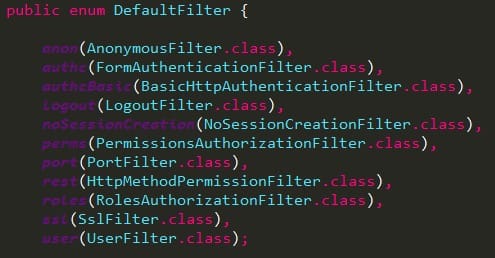
| Filter | 解释 |
|---|---|
| anon | 无参,开放权限,可以理解为匿名用户或游客 |
| authc | 无参,需要认证 |
| logout | 无参,注销,执行后会直接跳转到shiroFilterFactoryBean.setLoginUrl(); 设置的 url |
| authcBasic | 无参,表示 httpBasic 认证 |
| user | 无参,表示必须存在用户,当登入操作时不做检查 |
| ssl | 无参,表示安全的URL请求,协议为 https |
| perms[user] | 参数可写多个,表示需要某个或某些权限才能通过,多个参数时写 perms[“user, admin”],当有多个参数时必须每个参数都通过才算通过 |
| roles[admin] | 参数可写多个,表示是某个或某些角色才能通过,多个参数时写 roles[“admin,user”],当有多个参数时必须每个参数都通过才算通过 |
| rest[user] | 根据请求的方法,相当于 perms[user:method],其中 method 为 post,get,delete 等 |
| port[8081] | 当请求的URL端口不是8081时,跳转到 schemal://serverName:8081?queryString 其中 schmal 是协议 http 或 https 等等,serverName 是你访问的 Host,8081 是 Port 端口,queryString 是你访问的 URL 里的 ? 后面的参数常用的主要就是 anon,authc,user,roles,perms 等 |
注意:anon, authc, authcBasic, user 是第一组认证过滤器,perms, port, rest, roles, ssl 是第二组授权过滤器,要通过授权过滤器,就先要完成登陆认证操作(即先要完成认证才能前去寻找授权) 才能走第二组授权器(例如访问需要 roles 权限的 url,如果还没有登陆的话,会直接跳转到 shiroFilterFactoryBean.setLoginUrl(); 设置的 url )
自定义 realm 类
我们首先要继承 AuthorizingRealm 类来自定义我们自己的 realm 以进行我们自定义的身份,权限认证操作。
记得要 Override 重写 doGetAuthenticationInfo 和 doGetAuthorizationInfo 两个方法(两个方法名很相似,不要搞错)
public class CustomRealm extends AuthorizingRealm {
private UserMapper userMapper;
@Autowired
private void setUserMapper(UserMapper userMapper) {
this.userMapper = userMapper;
}
/**
* 获取身份验证信息
* Shiro中,最终是通过 Realm 来获取应用程序中的用户、角色及权限信息的。
*
* @param authenticationToken 用户身份信息 token
* @return 返回封装了用户信息的 AuthenticationInfo 实例
*/
@Override
protected AuthenticationInfo doGetAuthenticationInfo(AuthenticationToken authenticationToken) throws AuthenticationException {
System.out.println("————身份认证方法————");
UsernamePasswordToken token = (UsernamePasswordToken) authenticationToken;
// 从数据库获取对应用户名密码的用户
String password = userMapper.getPassword(token.getUsername());
if (null == password) {
throw new AccountException("用户名不正确");
} else if (!password.equals(new String((char[]) token.getCredentials()))) {
throw new AccountException("密码不正确");
}
return new SimpleAuthenticationInfo(token.getPrincipal(), password, getName());
}
/**
* 获取授权信息
*
* @param principalCollection
* @return
*/
@Override
protected AuthorizationInfo doGetAuthorizationInfo(PrincipalCollection principalCollection) {
System.out.println("————权限认证————");
String username = (String) SecurityUtils.getSubject().getPrincipal();
SimpleAuthorizationInfo info = new SimpleAuthorizationInfo();
//获得该用户角色
String role = userMapper.getRole(username);
Set<String> set = new HashSet<>();
//需要将 role 封装到 Set 作为 info.setRoles() 的参数
set.add(role);
//设置该用户拥有的角色
info.setRoles(set);
return info;
}
}
重写的两个方法分别是实现身份认证以及权限认证,shiro 中有个作登陆操作的 Subject.login() 方法,当我们把封装了用户名,密码的 token 作为参数传入,便会跑进这两个方法里面(不一定两个方法都会进入)
其中 doGetAuthorizationInfo 方法只有在需要权限认证时才会进去,比如前面配置类中配置了 filterChainDefinitionMap.put("/admin/**", "roles[admin]"); 的管理员角色,这时进入 /admin 时就会进入 doGetAuthorizationInfo 方法来检查权限;而 doGetAuthenticationInfo 方法则是需要身份认证时(比如前面的 Subject.login() 方法)才会进入
再说下 UsernamePasswordToken 类,我们可以从该对象拿到登陆时的用户名和密码(登陆时会使用 new UsernamePasswordToken(username, password);),而 get 用户名或密码有以下几个方法
token.getUsername() //获得用户名 String
token.getPrincipal() //获得用户名 Object
token.getPassword() //获得密码 char[]
token.getCredentials() //获得密码 Object
注意:有很多人会发现,UserMapper 等类,接口无法通过 @Autowired 注入进来,跑程序的时候会报 NullPointerException,网上说了很多诸如是 Spring 加载顺序等原因,但其实有一个很重要的地方要大家注意,CustomRealm 这个类是在 shiro 配置类的 securityManager.setRealm() 方法中设置进去的,而很多人直接写securityManager.setRealm(new CustomRealm()); ,这样是不行的,必须要使用 @Bean 注入 MyRealm,不能直接 new 对象:
@Bean
public SecurityManager securityManager() {
DefaultWebSecurityManager securityManager = new DefaultWebSecurityManager();
// 设置realm.
securityManager.setRealm(customRealm());
return securityManager;
}
@Bean
public CustomRealm customRealm() {
return new CustomRealm();
}
道理也很简单,和 Controller 中调用 Service 一样,都是 SpringBean,不能自己 new
当然,同样的道理也可以这样写:
@Bean
public SecurityManager securityManager(CustomRealm customRealm) {
DefaultWebSecurityManager securityManager = new DefaultWebSecurityManager();
// 设置realm.
securityManager.setRealm(customRealm);
return securityManager;
}
然后只要在 CustomRealm 类加上个类似 @Component 的注解即可
功能实现
本文的功能全部以接口返回 json 数据的方式实现
根据 url 权限分配 controller
//游客
@RestController
@RequestMapping("/guest")
public class GuestController{
@Autowired
private final ResultMap resultMap;
@RequestMapping(value = "/enter", method = RequestMethod.GET)
public ResultMap login() {
return resultMap.success().message("欢迎进入,您的身份是游客");
}
@RequestMapping(value = "/getMessage", method = RequestMethod.GET)
public ResultMap submitLogin() {
return resultMap.success().message("您拥有获得该接口的信息的权限!");
}
}
// 普通登陆用户
@RestController
@RequestMapping("/user")
public class UserController{
@Autowired
private final ResultMap resultMap;
@RequestMapping(value = "/getMessage", method = RequestMethod.GET)
public ResultMap getMessage() {
return resultMap.success().message("您拥有用户权限,可以获得该接口的信息!");
}
}
管理员
@RestController
@RequestMapping("/admin")
public class AdminController {
@Autowired
private final ResultMap resultMap;
@RequestMapping(value = "/getMessage", method = RequestMethod.GET)
public ResultMap getMessage() {
return resultMap.success().message("您拥有管理员权限,可以获得该接口的信息!");
}
}
突然注意到 CustomRealm 类那里抛出了 AccountException 异常,现在建个类进行异常捕获
@RestControllerAdvice
public class ExceptionController {
private final ResultMap resultMap;
@Autowired
public ExceptionController(ResultMap resultMap) {
this.resultMap = resultMap;
}
// 捕捉 CustomRealm 抛出的异常
@ExceptionHandler(AccountException.class)
public ResultMap handleShiroException(Exception ex) {
return resultMap.fail().message(ex.getMessage());
}
}
还有进行登陆等处理的 LoginController
@RestController
public class LoginController {
@Autowired
private ResultMap resultMap;
private UserMapper userMapper;
@RequestMapping(value = "/notLogin", method = RequestMethod.GET)
public ResultMap notLogin() {
return resultMap.success().message("您尚未登陆!");
}
@RequestMapping(value = "/notRole", method = RequestMethod.GET)
public ResultMap notRole() {
return resultMap.success().message("您没有权限!");
}
@RequestMapping(value = "/logout", method = RequestMethod.GET)
public ResultMap logout() {
Subject subject = SecurityUtils.getSubject();
//注销
subject.logout();
return resultMap.success().message("成功注销!");
}
/**
* 登陆
*
* @param username 用户名
* @param password 密码
*/
@RequestMapping(value = "/login", method = RequestMethod.POST)
public ResultMap login(String username, String password) {
// 从SecurityUtils里边创建一个 subject
Subject subject = SecurityUtils.getSubject();
// 在认证提交前准备 token(令牌)
UsernamePasswordToken token = new UsernamePasswordToken(username, password);
// 执行认证登陆
subject.login(token);
//根据权限,指定返回数据
String role = userMapper.getRole(username);
if ("user".equals(role)) {
return resultMap.success().message("欢迎登陆");
}
if ("admin".equals(role)) {
return resultMap.success().message("欢迎来到管理员页面");
}
return resultMap.fail().message("权限错误!");
}
}
测试
登陆前访问信息接口
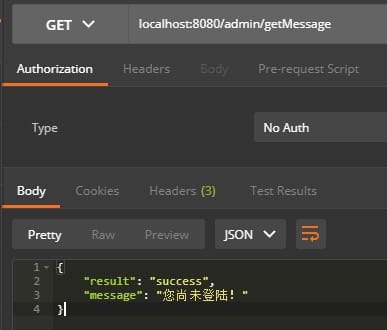
普通用户登陆
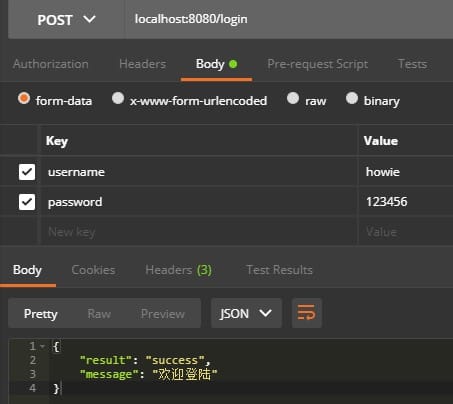
密码错误
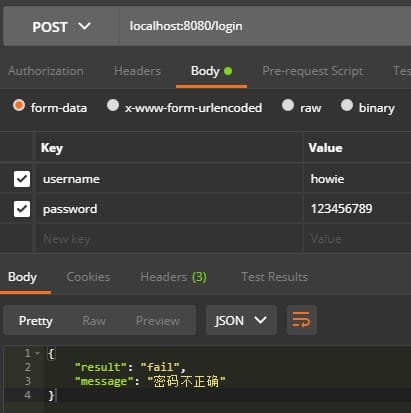
管理员登陆
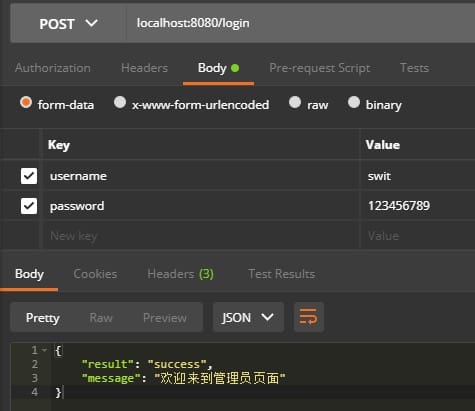
获取信息

获取信息

注销
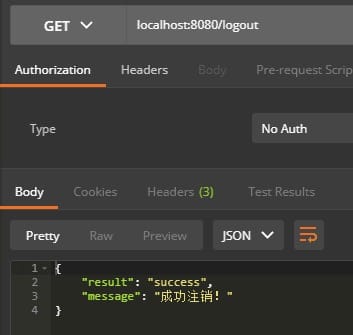
附上源码
附上源码:https://github.com/uniquezhangqi/Shiro-SpringBoot

